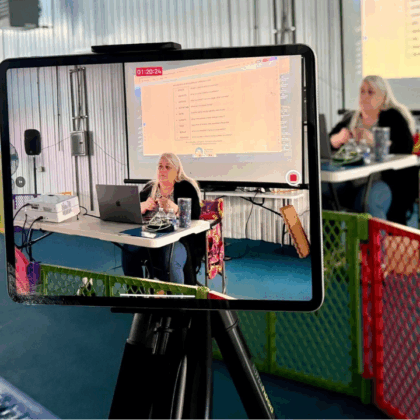There’s a moment in every dog trainer’s development when they realize the gap between what they thought they were seeing and what was actually happening.
Maybe it’s watching an experienced trainer work with a reactive dog, seeming to make adjustments before the dog even shows obvious signs of stress. Maybe it’s reviewing video of your own session and noticing details you completely missed in real time. Maybe it’s having an expert point out patterns that were happening right in front of you but remained invisible until someone else named them.
This gap between novice observation and expert perception isn’t about talent or natural ability. It’s about systematic skill development that most trainers never receive.
What Happens When Your Observation Skills Are Sharp
Picture two trainers working with the same dog presenting leash reactivity:
Trainer A sees a dog who “goes crazy” when other dogs appear. They focus on the obvious behaviors – barking, lunging, pulling – and apply techniques designed to interrupt or redirect these responses. Their timing is based on when the dramatic behaviors occur.
Trainer B sees the subtle weight shift that happens three seconds before the barking starts, the brief ear flick that signals the dog first noticed the approaching trigger, the handler’s unconscious tension that travels down the leash and influences the dog’s arousal level. Their interventions happen in the space between stimulus and reaction, often preventing the dramatic behaviors entirely.
Same dog. Same situation. Completely different outcomes because of observation skills that allow one trainer to see the early stages of the behavioral sequence while the other only notices the end result.
This isn’t magic – it’s systematic training in what to look for and when to look for it.
The Professional Difference
When clients work with truly skilled trainers, they often comment that it seems almost magical how quickly the trainer understands their dog. “She knew exactly what was wrong after watching him for just a few minutes.” “He saw things I never noticed even though I live with this dog every day.” “She predicted what would happen before it happened.”
This apparent intuition is actually the result of pattern recognition built through systematic observation practice. Expert trainers have learned to see:
- Subtle precursors to obvious behaviors – the micro-expressions and body language changes that predict what’s coming next.
- Multiple variables simultaneously – tracking handler stress, environmental factors, physical comfort, arousal level, and social dynamics all at once.
- Individual differences within similar presentations – understanding why the same technique works beautifully for one dog and fails completely with another who appears to have the same problem.
- Context effects – recognizing how time of day, location, recent experiences, and social environment influence behavior in ways that aren’t immediately obvious.
The Cost of Inadequate Observation
- What happens when trainers lack systematic observation skills?
- Misdiagnosis: Treating symptoms instead of causes. The “aggressive” dog who’s actually in pain. The “stubborn” dog who can’t hear properly. The “anxious” dog responding normally to actual threats in their environment.
- Poor timing: Interventions that come too late to be effective, reinforcing the wrong behaviors because the critical moments were missed, corrections that address normal responses to confusing situations.
- Generic approaches: Applying the same techniques regardless of individual differences, missing the specific triggers and motivations that make training plans effective for particular dogs.
- Relationship damage: Blaming dogs for problems they can’t control, using unnecessary corrections when environmental management would be more appropriate, creating learned helplessness through mismatch between training methods and individual needs.
Beyond Individual Skills to Professional Mastery
Advanced observation skills change how trainers approach every aspect of professional practice:
- Initial assessments become more accurate because they’re gathering better information about what’s actually happening rather than what appears to be happening.
- Training plan development improves because they understand the real causes behind behavioral symptoms rather than just addressing surface manifestations.
- Progress monitoring becomes more sensitive because they can detect subtle changes that indicate improvement or emerging problems.
- Client education becomes more effective because they can help people see what their dogs are actually communicating rather than what they assume the behaviors mean.
- Professional credibility increases as clients recognize their ability to understand dogs quickly and accurately.
The Relationship Foundation
Beyond practical benefits lies something deeper: the recognition that skilled observation is fundamentally about relationship. When we truly see another being – whether dog or human – we honor their individuality and create space for authentic communication.
Dogs are constantly sharing information through their behavior, posture, movement patterns, and responses to environmental changes. But this communication only works if someone on the other end has developed the skills to receive it accurately.
Every dog deserves to be seen clearly for who they are in each moment rather than filtered through assumptions, expectations, or professional blind spots. Past being more effective trainers, we are creating the foundation for genuine relationships built on understanding rather than projection.
The most successful trainers aren’t those who know the most techniques. They’re the ones who see most clearly what each individual dog actually needs. This distinction – between technical knowledge and perceptual skill – often determines whether training creates lasting positive change or temporary behavioral compliance.
Professional competency in dog training requires systematic development of observation abilities that match the complexity of the work. This is a learnable skill, but it requires the same dedicated practice as any other professional competency.
Develop pattern recognition – like Karl von Frisch spending decades observing honey bees until he decoded their “waggle dance” communication system.
Create effective field notes – capturing complex, fast-moving behavior in ways that remain meaningful months later.
Practice scientific inquiry – approaching each interaction with curiosity, working hypotheses, and real-world research skills.

